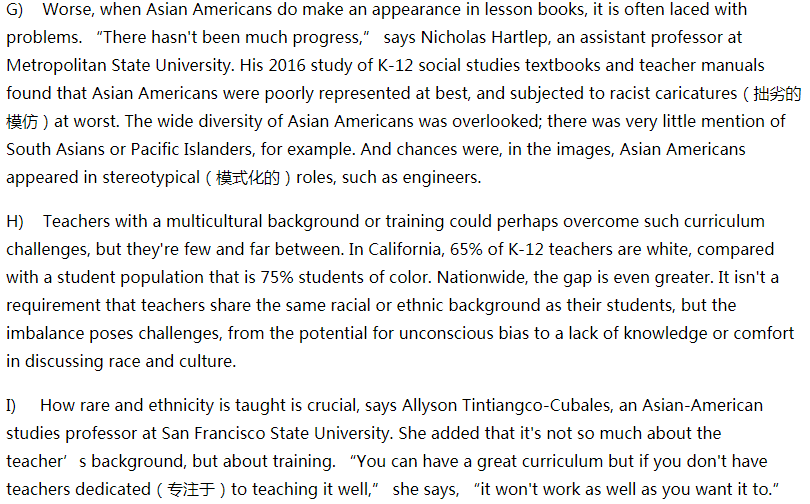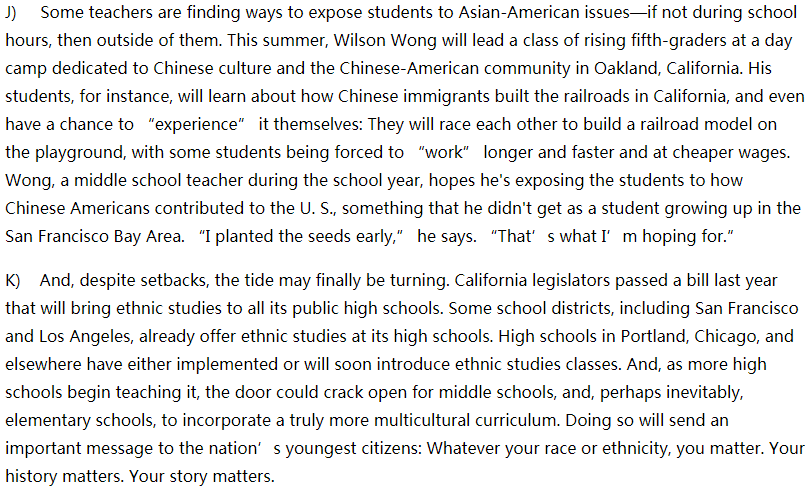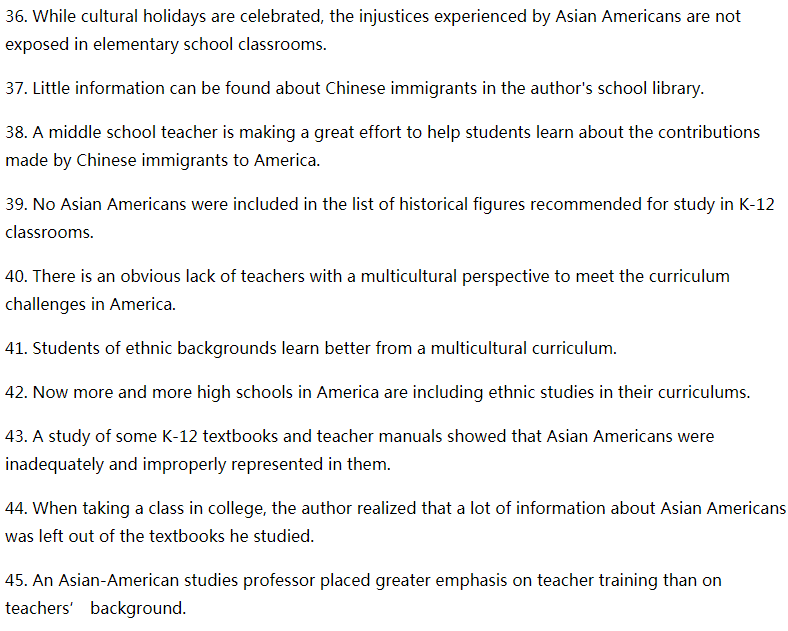A)I still remember my fourth-grade social studies project. Our class was studying the Gold Rush, something all California fourth-graders learned. I was excited because I had asked to research Chinese immigrants during that era. Growing up in the San Francisco Bay Area, I had always known that “San Francisco” translated to “Gold Mountain” in Chinese. The name had stuck ever since Chinese immigrants arrived on the shores of Northern California in the 1850s, eager to try their luck in the gold mines. Now l*d have the chance to learn about them.
B)My excitement was short-lived. I remember heading to the library with my class and asking for help. I remember the librarian's hesitation. She finally led me past row after row of books, to a comer of the library where she pulled an oversized book off the shelf. She checked the index and turned over to a page about early Chinese immigrants in California. That was all there was in my entire school library in San Francisco, home of the nation's first Chinatown. That was it.
C)I finally had the opportunity to learn about Asian Americans like myself, and how we became part of the fabric of the United States when I took an introductory class on Asian-American history in college. The class was a revelation. I realized how much had been missing in my textbooks as I grew up. My identity had been shaped by years of never reading, seeing, hearing, or learning about People who had a similar background as me. Why, I wondered, weren't the stories, histories, and contributions of Asian Americans taught in K-12 schools, especially in the elementary schools? Why are they still not taught?
D)Our students—Asian, Latino, African American, Native American and white—stand to gain from a multicultural curriculum. Students of color are more engaged and earn better grades when they see themselves in their studies. Research has also found that white students benefit by being challenged and exposed to new perspectives.
E)For decades, activists have called for schools to offer anti-racism or multicultural curricula. Yet a traditional American K-12 curriculum continues to be taught from a Eurocentric point of view. Being multicultural often fall back on weaving children of color into photographs, or creating a few supporting characters that happen to be ethnic—an improvement, but superficial nonetheless. Elementary school classrooms celebrate cultural holidays—Lunar New Year! Red envelopes! Lion dancers! — but they’re quick to gloss over(掩饰)the challenges and injustices that Asian Americans have faced. Most students don't, for example, learn about the laws that for years excluded Asians from immigrating to the U. S. They don't hear the narratives of how and why Southeast Asian refugees(难民)had to rebuild their lives here.
F)Research into what students learn in school has found just how much is missing in their studies. In an analysis, Christine Sleeter, a professor in the College of Professional Studies at California State University, Monterey Bay, reviewed California's history and social studies framework, the curriculum determined by state educators that influences what is taught in K-12 classrooms. Of the nearly 100 Americans recommended to be studied, 77% were white, 18% African American, 4% Native American, and 1% Latino. None were Asian American.



正确答案及解析
正确答案
【36-40】 HELGD【41-45】 ICKFB
解析
你可能感兴趣的试题
Directions: For this part, you are allowed 30 minutes to write a letter to a foreign friend who wants to study in China. Please recommend a university to him. You should write at least 120 words but no more than 180 words.
- 查看答案
Directions: For this part, you are allowed 30 minutes to write a letter to a foreign friend who wants to teach English. Please recommend a city to him. You should write at least 120 words but no more than 180 words.
- 查看答案
中国,地球上最吸引人的国家之一,有5000多年的历史,是目前全球第二大经济体(the second largest economy)。随着广泛的经济改革,中国正经历着显著、快速的变化。1949年以前的中国极端贫困、收入不平衡(incomeinequalities)、国家不安全。由于经济改革,从1980年开始,人民的生活水平开始提升至基本水平之上。全国人口有了足够的食物、衣服和住房,普通家庭可以吃得起各种各样的食物,穿得上时尚的衣服。
- 查看答案
The fifth largest city in US passed a significant soda tax proposal that will levy (征税)1.5 cents per liquid ounce on distributors.
Philadelphil's new measure was approved by a 13 to 4 city council vote. It sets a new bar for similar initiatives across the country. It is proof that taxes on sugary drinks can win substantial support outside super-liberal areas. Until now, the only city to successfully pass and implement a soda tax was Berkeley, California, in 2014.
The tax will apply to regular and diet sodas, as well as other drinks with adder sugar, such as Gatorade and iced teas. It's expected to raise $410 million over the next five years, most of which will go toward funding a universal pre-kindergarten program for the city.
While the city council vote was met with applause inside the council room, opponents to the measure, including soda lobbyists, made sharp criticisms and a promise to challenge the tax in court.
"The tax passed today unfairly singles out beverages — including low —and no-calorie choices," said Lauren Kane, spokeswoman for the American Beverage Association. "But most importantly, it is against the law. So we will side with the majority of the people of Philadelphia who oppose this tax and take legal action to stop it."
An industry-backed anti-tax campaign has spent at least $4 million on advertisements. The ads criticized the measure, characterizing it as a "grocery tax".
Public health groups applauded the approved tax as step toward fixing certain lasting health issues that plague Americans. "The move to recapture a small part of the profits from an industry that pushed a product that contributes to diabetes, obesity and heart disease in poorer communities in order to reinvest in those communities will sure be inspirational to many other places," said Jim Krieger, executive director of Healthy Food America. "indeed, we are already hearing from some of them. It's not 'just Berkeley' anymore."
Similar measures in California's Albany, Oakland, San Francisco and Colorado's Boulder are becoming hot-button issues. Health advocacy groups have hinted that even more might be coming.
46. What does the passage say about the newly-approved soda tax in Philadelphia?
A) It will change the lifestyle of many consumers.
B) It may encourage other US cities to fllow suit.
C) It will cut soda consumption among low-income communities.
D) It may influence the marketing strategies of the soda business.
47. What will the opponents probably do to respond to the soda tax proposal?
A) Bargain with the city council.
B) Refuse to pay additional tax.
C) Take legal action against it.
D) Try to win public support.
48. What did the industry-backed anti-tax campaign do about the soda tax proposal?
A) It tried to arouse hostile felings among consumers.
B) It tried to win grocers' support against the measure.
C) It kept sending ltters of protest to the media.
D) It criticized the measure through advertising.
49. What did public health groups think the soda tax would do?
A) Alert people to the risk of sugar-induced diseases.
B) Help people to fix certain long-time health issues.
C) Add to the fund for their rescarch on discases.
D) Benefit low-income people across the country.
50. What do we lear about similar measures concening the soda tax in some other citics?
A) They are becoming rather sensitive issues.
B) They are spreading panic in the soda industry.
C) They are reducing the incidence of sugar-induced diseases.
D) They are taking away a lot of proft from the soda industry.
- 查看答案
鱼是春节前夕餐桌上不可或缺的一道菜,因为汉语中“鱼”字的发音与“余”字的发音相同。正由于这个象征性的意义,春节期间鱼也作为礼物送给亲戚朋友。鱼的象征意义据说源于中国传统文化。中国人有节省的传统,他们认为节省得愈多,就感到愈为安全。今天,尽管人们愈来愈富裕了,但他们仍然认为节省是一种值得弘扬的美德。
- 查看答案